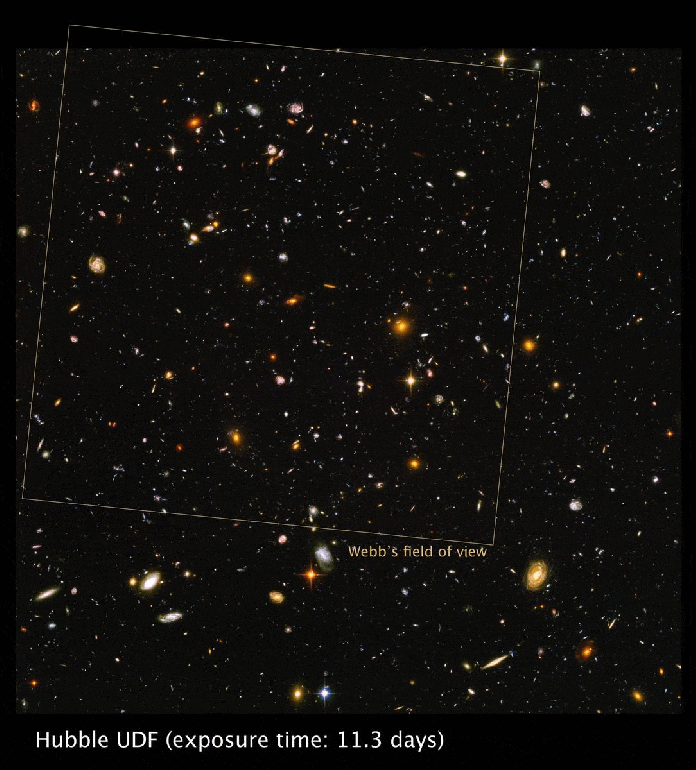Sign up for the Starts With a Bang newsletter
Travel the universe with Dr. Ethan Siegel as he answers the biggest questions of all.
Our Universe, today, contains trillions of galaxies with sextillions of stars.

Taking us beyond the limits of any prior observatory, including all of the ground-based telescopes on Earth as well as Hubble, NASA’s JWST has shown us the most distant galaxies in the Universe ever discovered. If we assign 3D positions to the galaxies that have been sufficiently observed-and-measured, we can construct a visualized fly-through of the Universe, as the CEERS data from JWST enables us to do here. At greater distances, compact, star-forming galaxies are more common; at closer distances, more diffuse, quiescent galaxies are the norm.
But 13.8 billion years ago, there were none at all.

In the aftermath of inflation, signatures are imprinted onto the Universe that are unmistakably inflationary in origin. While the CMB provides an early-time “snapshot” of these features, that’s just one moment in history. By probing the large variety of times/distances accessible to us throughout cosmic time, such as with large-scale structure, we can obtain information that would otherwise be obscure from any single snapshot.
It takes both time and gravity for modern cosmic structures to evolve.

This snippet from a structure-formation simulation, with the expansion of the Universe scaled out, represents billions of years of gravitational growth in a dark matter-rich Universe. Over time, overdense clumps of matter grow richer and more massive, growing into galaxies, groups, and clusters of galaxies, while the less dense regions than average preferentially give up their matter to the denser surrounding areas. The “void” regions between the bound structures continue to expand, but the structures themselves do not.
To understand how it occurred, we need to map cosmic structure throughout history.

With appropriate measurements taken in a variety of wavelength filters, distances and lookback times can be inferred for each galaxy imaged in a deep field view of the Universe. Galaxies can be sorted into nearby, intermediate-distance, and great distance bins in the Universe. The earliest galaxies found in the deepest images of the Universe take us back to merely a few hundred million years after the Big Bang.
This includes galaxies,

The early results of the GLASS Early Release Science program reveal over 200 sources that span a variety of ranges in redshift and mass. This helps teach us what shapes galaxies take on over a range of masses and stages in cosmic time/evolution, revealing a number of very massive, very early, yet very evolved-looking galaxies. By observing a wide variety of galaxies and galactic structures throughout cosmic history, we can better learn how our Universe, and the objects within it, grew up.
Credit: C. Jacobs, K. Glazebrook et al., arXiv:2208.06516, 2022
galaxy clusters,

The galaxies that are members of the identified protocluster A2744z7p9OD are shown here, outlined atop their positions in the JWST view of galaxy cluster Abell 2744. At just 650 million years after the Big Bang, it’s the oldest protocluster of galaxies ever identified. This is early, but is consistent with simulations of when the earliest protoclusters should emerge from the most initially overdense regions.
and more.

This animation switches points of view between the Hubble Ultra Deep Field and the JWST view of an overlapping region of space. Because of the difference in telescope size and resolution, the JWST views are downsampled by about a factor of 4 in resolution to make these two images match.
JWST’s first deep, wide-field survey — COSMOS-Web — was designed for exactly this.

The COSMOS-Web survey (renamed from COSMOS-Webb, as it will survey a portion of the cosmic web) will map 0.6 square degrees of the sky — about the area of three full Moons — using the James Webb Space Telescope’s Near Infrared Camera (NIRCam) instrument, while simultaneously mapping a smaller 0.2 square degrees with the Mid Infrared Instrument (MIRI). It will doubtlessly reveal many faint and distant galaxies that were unobservable to Hubble, and should help enlighten us as to how the Universe grew up. Spectroscopic follow-up on many of the most distant galaxy candidates within this field should help us understand whether the early JWST results truly indicate an anomaly in how quickly galaxies grow up in the Universe.
Prior to JWST’s launch, expectations for novel discoveries were high.

Preliminary total system throughput for each NIRCam filter, including contributions from the JWST Optical Telescope Element (OTE), NIRCam optical train, dichroics, filters, and detector quantum efficiency (QE). Throughput refers to photon-to-electron conversion efficiency. By using a series of JWST filters extending to much longer wavelengths than Hubble’s limit (between 1.6 and 2.0 microns), JWST can reveal details that are completely invisible to Hubble. The more filters that are leveraged in a single image, the greater the amount of details and features that can be revealed.
Astronomers conducted simulations to help guide expectations.

The full DREaM simulated galaxy catalog was used to provide a full square degree’s view of what a survey with James Webb would be able to see. Included in this view are many times the total number of galaxies that Hubble, even with its deepest, longest views, was capable of revealing. The actual COSMOS-Web survey, at 0.54 square degrees, is the largest initial survey with JWST to rival such large amounts of data.
Now, in 2025, the COSMOS-Web survey’s results have finally arrived.

This low-resolution image shows the full field of the COSMOS-Web survey conducted with JWST. Spanning 0.54 square degrees in the sky, or nearly three full Moons’ worth of area, this represents the largest, deepest wide-field view of the Universe ever acquired.
The full 166 Megapixel image uses infrared data from Hubble and JWST, with X-ray data also available.

This image composite shows the full-field of the COSMOS-Web survey, using a combination of JWST NIRCam and Hubble infrared data, with X-ray data from the Chandra X-ray telescope overlaid in violet.
This is the widest-area, deepest JWST survey ever undertaken, revealing a variety of fascinating details.

This small portion of the COSMOS-Web survey reveals about ~5% of the total survey area, showcasing stars within the Milky Way, a few relatively nearby galaxies, more distant galaxies that are part of a massive, distant, galaxy cluster and ultra-distant galaxies from very early on in cosmic history. The shapes of many background galaxies are distorted by the effects of gravitational lensing.
The eight-pointed diffraction spikes highlight stars within the Milky Way.

Every bright point source, like the stars within our Milky Way, comes along with a unique 8-point set of diffraction spikes: two small ones and 6 large ones, owing to the shape of JWST’s primary mirror and the struts that hold the secondary mirror in place. The foreground Milky Way stars shown here have four additional, tilted spikes arising from the infrared Hubble imagery combined with the JWST data.
Despite 255 hours of JWST observations, some sky patches remain almost completely dark.

This portion of the COSMOS-Web survey has only a small number of faint, distant galaxies within it, revealing a mostly “blank” patch of sky. This region likely corresponds to a set of cosmic voids along this particular line-of-sight, enabling largely pristine, unobscured studies of the galaxies that do happen to be located in this region.
Others, however, reveal rich groups and clusters of galaxies.

This region of space, of approximately the same size and area as the previous sparse region, instead shows a large group of foreground galaxies with a rich population of background galaxies located behind them. The bright central spike-rich galaxy likely contains an active supermassive black hole at its center.
The COSMOS-Web survey’s main feature is a galaxy cluster located 9.9 billion light-years away.

The largest concentration of galaxies in the COSMOS-Web survey is highlighted by a chain of glowing, gas-rich galaxies with massive stellar halos whose light is coming to us from when the Universe was only 6.5 billion years old. Many more distant galaxies are affected by the gravitational influence of these foreground galaxies within the greater massive, extended galaxy cluster.
Many COSMOS-Web galaxies display huge, extended stellar halos.

The largest galaxies displayed here aren’t blurry because they’re overexposed or because of atmospheric interference, but rather because JWST is outstandingly exposing their diffuse, extended stellar halos. Behind the central and lower-right galaxies are more distant, gravitationally lensed background galaxies.
Meanwhile, gravitational lensing distorts the shape of background galaxies.

This large, massive galaxy at the center of a compact group of galaxies within the COSMOS-Web field heavily distorts the space around it, causing the background galaxies to be stretched and distorted by the effects of weak gravitational lensing. A few strong lensing candidates can be seen in this field as well.
Large area galaxy surveys,

From isolated galaxies to quiet, lonesome spirals to dense galactic groups involved in ongoing smash-ups and mergers, galaxy evolution is best studied through large-area surveys spanning huge portions of cosmic history.
revealing spirals, ellipticals, and irregulars,

This region of the COSMOS-Web survey highlights three prominent, relatively nearby and structure-rich spiral galaxies. However, the redder-colored galaxies are more distant and less evolved. Seeing similar types of galaxies throughout cosmic history can teach us how our Universe grew up.
showcase cosmic evolution’s profound effects.

With many spiral and elliptical galaxies found at a variety of distances, it’s easy to overlook the few irregular, interacting galaxies, such as the one at the center of the image shown here. But these rare interacting pairs of galaxies also hold tremendous lessons for cosmic and galactic evolution.
Mostly Mute Monday tells an astronomical story in images, visuals, and no more than 200 words.
Sign up for the Starts With a Bang newsletter
Travel the universe with Dr. Ethan Siegel as he answers the biggest questions of all.
